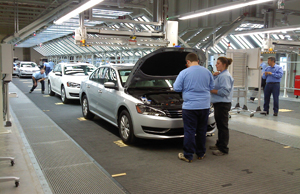
CHATTANOOGA, TN – As Volkswagen of America inches its way toward the goal of selling 800,000 vehicles in the U.S. by 2018, President and CEO Jonathan Browning says the existing dealer pool of 588 stores will be adequate to handle rising volumes over the next three years.
In the near term, “evolutionary” change at the dealer level should accommodate sales that are expected to balloon beyond the 2010 tally of 256,830 units in the U.S.
But by 2014, Browning tells Ward’s an expanded dealer pool will be necessary, and “radical change” will be in order.
“Then we’ll need to step up in terms of the dealer count across the country,” he says during an interview at VW’s new plant here as it prepares to launch the new-for-’12 Passat for the North American market. “But our first focus is very much using the capacity in the existing network.” Browning says VW dealers collectively have sold 500,000 vehicles a year in the past.
But it’s been 40 years since they surpassed the half-million mark (532,904 units in 1971), according to Ward’s historical data. The brand’s high-water mark came a year earlier, in 1970, when 582,573 deliveries were made.
Ever since, VW’s experience in the U.S. has been a hair-raising rollercoaster ride, plummeting to 68,365 in 1982, rebounding to 143,065 in 1986, plunging to the brink with 49,533 in 1993, then ascending to 355,648 units in 2001 before trending downward throughout the decade.
Still, with fresh product filling the pipeline, Browning is confident sales will show steady improvement.
“Our dealer body is really excited about what’s happening, about this very clear commitment to the U.S. market, the investment in not only the plant here but the production coming into the U.S. There’s a real sense of enthusiasm within the network.”

The re-engineered Passat, as well as the new Jetta and upcoming Beetle, both produced in Puebla, Mexico, promise to drive prospective first-time customers into VW showrooms. A hybrid Jetta and high-performance Golf R 5-door hatchback also are expected in 2012.
Midsize-car buyers generally drawn to high-volume vehicles such as the Toyota Camry, Honda Accord, Nissan Altima, Chevy Malibu and Ford Fusion are bound to shop the Passat, which is expected to be competitively base-priced at about $20,000. That’s down significantly from the previous, smaller Passat, which started above $27,000.
“The dealer body absolutely is fundamental to achieving the growth plan,” Browning says. “And we see them as being well prepared for that challenge.”
Since the new-for-’11 Jetta launched last September (also at a lower base price than the model it replaced), VW showrooms have been welcoming new customers who have had limited experience with the auto maker based in Wolfsburg, Germany.
Some 60% of Jetta buyers are trading in competitive vehicles, Browning says.
“They’re a dealer body that’s obviously very comfortable with the existing customer base but also very comfortable with bringing in new customers from outside the franchise as well.”

So how many U.S. dealers will VW need to handle the 800,000-unit plateau?
“You tell me what the industry will be in 2018, and I’ll tell you a number of dealers,” Browning says. “In simple terms, we’re not assuming the industry gets back to pre-crisis levels. We’ve set our longer-term planning around the 15- to 16-million industry (U.S. sales) level. But who knows what cycles we’ll go through between now and then?”
VW management will decide within two years whether to bring the Phaeton flagship sedan back to the U.S., he notes. The luxury car was available here from 2003 to 2007, and sales over the five years totaled a meager 3,354 units, according to Ward’s data.
Although the new Passat is larger than the vehicle it replaces, Browning says consumers would not cross-shop it with the Phaeton, which is suited for a far more affluent buyer.
Until the Phaeton returns, Browning says the Touareg cross/utility vehicle “is doing a great job in providing that halo within the brand.”
The Touareg accommodates five occupants, and Browning says VW needs a vehicle that fits seven. Whether the first 7-passenger vehicle for the U.S. is derived from the Touareg or the Bulli Microbus concept shown in Geneva remains to be decided.
On the powertrain front, Browning says about 20% of all VW vehicles sold in the U.S. have TDI clean diesel engines, which he sees as an encouraging trend as the auto maker stretches to meet the corporate average fuel economy mandate of 35.5 mpg (6.6 L/100 km) by 2016. A record 57% of Golf models sold in February were TDIs.
“We’re very much committed to diesel, not across every vehicle, but certainly across the major vehicles, he says.
The Tiguan CUV is being considered for the addition of a diesel engine for the U.S. market, VW sources say. A 2.0L TDI will be one of three engines available in the all-new Passat when it goes on sale in September in the U.S.

